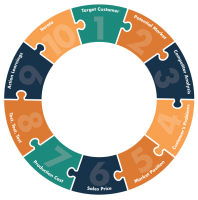Make your new product more sellable

You’re designing a new product or services. What next? Are you going to build your product or service, launch it with marketing support and hope customers will buy?
This is a typical process followed by many businesses, large and small. Its roots lie in our manufacturing past where we created a new product and put it into the marketplace. We supported its launch with marketing campaigns to make customers aware of our product, the benefits and why they should buy it. If enough customers were reached, the product would be a success.
Nowadays this approach is not sufficient. The customers have become far more sophisticated and the competition is fiercer.
A high failure rate
Various studies have been undertaken on new product launches. Seven out of ten products fail, according to a 2014 study by Simon Kurher & Partners. Other surveys indicate a wide range of failure rates, with some suggesting failure rates approaching 90% in some sectors.
It is terrible to see all that effort and money put into something that fails. That failure may represent an entrepreneur’s dream. Or it might be a business’s hope to revitalise its fortunes. The best case is a successful business wasting money and time pursuing new product that doesn’t work, but doesn’t cause disruption in the main business.
These failures represent a high cost: In money. In time. And ambitions.
The process we follow matters
There are many reasons for these product failures. One of key reasons is the process that is followed in the build up to launch is flawed or non-existent.
From our own experiences we know that the more testing you undertake with your target customer segment, the more you know your customer and the greater chance your product or services is going to be successful.
The process you follow prior to launching has a big impact on your success rate, the cost of launching and the time taken to get to meaningful revenues.
How much testing should I do?
The testing process takes time and effort. This means that a lot of people don’t undertake it or don’t undertake enough of it prior to launch.
The type of testing you undertake is important. For instance, if you only test for customer opinions you might fall foul of the positivity bias. People don’t want to hurt another’s feelings and therefore give a more favourable answer than they really believe. The UK culture provides more of this bias than many other cultures.
Opinion testing: “Mr Target Customer, here is my product and would you be interested in buying it?”
Instead, test for actions. This is a lot more valuable. After all, you want to know how the customer will act i.e. buy your product
Action testing: “Mr Target Customer, here is my product. There are x number of similar products in the marketplace, item x, item y and item z. In the last three months, how often have your purchased any of these products?”
The amount of testing depends on how well your product solves your target customer’s problems. If it solves painful or pressing problems well, then the testing may not take that long. If no painful or pressing customer problems are solved, it will take longer. You are more likely to have to amend your product or service to make it really compelling for your customers to buy.
Testing is not enough
Testing should provide greater knowledge of the customer, their problems and how well your product or service solves these problems.
You then need to use these learnings and make changes. This can be hard to do, particularly if you are heavily emotionally invested in your original idea. The changes needed may be small or significant to the product or service. Or perhaps you need to change your target customer. You want to be able to solve painful and/or pressing customer problems, so these customers are happy to buy your product for an attractive price. A price attractive to you and to the customer.
A structured process to increase your success rate
Using our experience of launching our own products and those of our clients, we have created a 10-step process to do before launching a new product or service. We know that this improves your chances of successfully launching a product as well as saving money and time.




